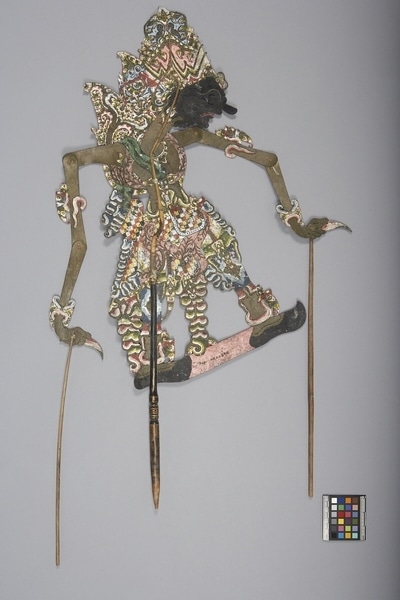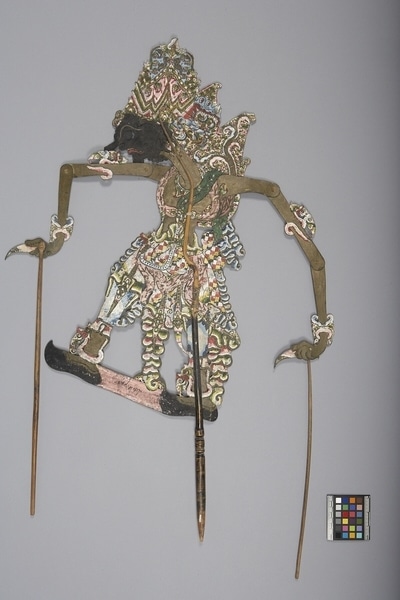Shadow Puppet Item Number: Ib418 from the MOA: University of British Columbia


Description
Two-dimensional male humanoid figure; large head and jointed arms attached to controlling rods. Face and body in profile; black face with incised features, long curved nose, large round eye, red lower lip and white teeth, hair and beard. Large crown (mahkota) headdress with diadem, karawista, Garuda Mungkur (short tongue), siyung jawi, and white badong (wing-like ridge). Neck and body gold; arms have ornate wrapped ornaments (red, white, green at biceps; white, red, and blue at wrists). Hands held clenched with blade-like appendages. Upper body has pink and green wrapped garments; extremely detailed skirt and apron over widespread feet with black upturned shoes. Base has inscriptions '1965 Oktober' on one side, and Javanese on the other (possibly an identification).
History Of Use
Boma is king (prabu) of Trajutrisna in the Mahabharata cycle. He is the son of Kresna, and an ally of the Pandawa Brothers. Reflects the traditions of wayang kulit which is the predominant theatrical form of Eastern and Central Java. The art form has its roots in the regional mythology, which was incompletely replaced by the Hinduism of invading Indians. The form has survived since then intact, even through the Islamic conquest. Plays, derived from the Mahabharata and Ramanayana cycles of legends, are performed by a dalang (puppet master) on special occasions, in three acts with vocal and instrumental accompaniment. Typically they serve a moral purpose, such as the fight between good and evil.
Cultural Context
Theatrical performance.
Iconographic Meaning
Each puppet is characterized by it's wanda, a Javanese word which describes the specific mixture of elements of size, form, colour, ornamentation and carving. Position of face suggests virtue; colour suggests spiritual maturity. Large facial features, large body are not refined. Skirt, arm ornaments, and skin colour suggest nobility. Crown (mahkota) indicate very high noble status (king or god). Wide stance and blades represent aggressive nature. Headdress, size, facial type, and hands identify character as Boma.
Item History
- Made in Bali, Indonesia
- Collected during 1977
- Owned by Kenzie M. N. Hoar before February 14, 1978
- Received from Kenzie M. N. Hoar (Donor) on February 14, 1978
What
- Name
- Shadow Puppet
- Identification Number
- Ib418
- Type of Item
- puppet
- Material
- leather skin, hemp fibre, fibre and paint
- Manufacturing Technique
- cut, pierced, tied and painted
- Overall
- height 66.0 cm, width 26.0 cm
Who
- Culture
- Balinese
- Previous Owner
- Kenzie M. N. Hoar
- Received from
- Kenzie M. N. Hoar (Donor)
Where
- Holding Institution
- MOA: University of British Columbia
- Made in
- Bali, Indonesia
When
- Collection Date
- during 1977
- Ownership Date
- before February 14, 1978
- Acquisition Date
- on February 14, 1978
Other
- Condition
- fair
- Accession Number
- 0435/0001